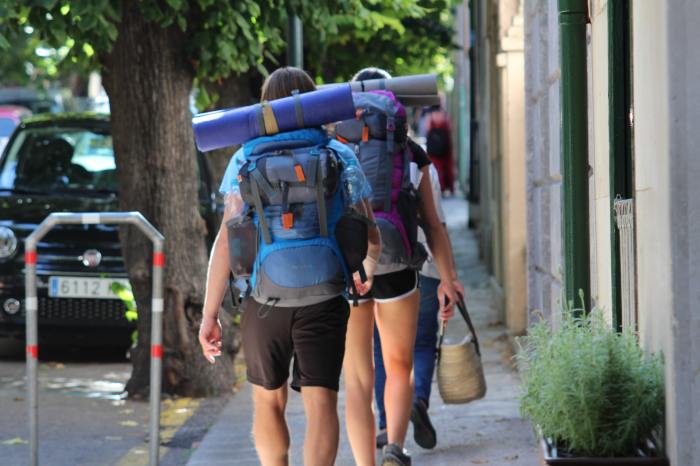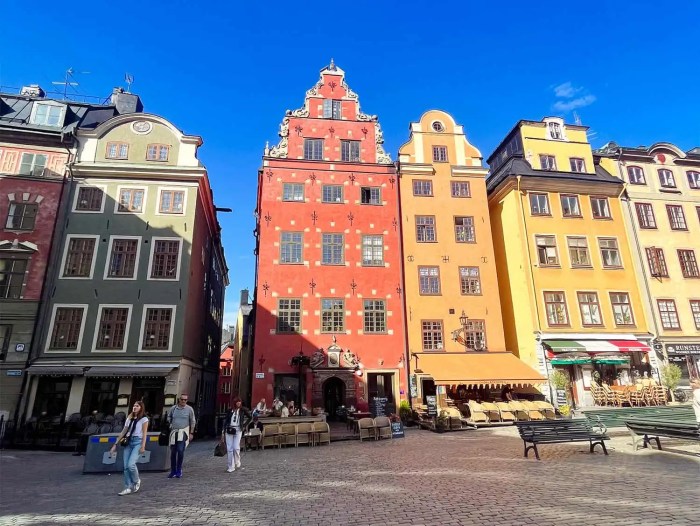Backpacking Europe Cost: Dreaming of exploring ancient ruins, vibrant cities, and breathtaking landscapes across Europe? The cost of your backpacking adventure can vary wildly depending on your style and choices. This guide breaks down the average expenses, offering practical strategies to maximize your experience without breaking the bank. We’ll cover accommodation, transportation, food, activities, and crafting a realistic budget, empowering you to plan an unforgettable trip.
From budget-friendly hostels to luxurious stays, from budget airlines to scenic train journeys, we’ll navigate the spectrum of options. Learn how to find incredible deals, avoid common pitfalls, and make your Euros stretch further. Whether you’re a seasoned backpacker or a first-timer, this comprehensive guide provides the insights you need to plan your European backpacking adventure with confidence.
Average Backpacking Europe Costs

Backpacking Europe can be an incredibly rewarding experience, offering a blend of history, culture, and breathtaking landscapes. However, understanding the costs involved is crucial for planning a successful and stress-free trip. This section will delve into the average daily expenses you can expect, allowing you to budget effectively and maximize your adventure. We’ll break down costs by region and travel style, providing a realistic picture of what you might spend.
Average Daily Expenses by Region and Travel Style
Budgeting for your backpacking trip requires a nuanced approach. The cost varies significantly depending on your chosen destinations and your preferred travel style. Western Europe tends to be more expensive than Eastern Europe, and opting for luxury accommodations and activities will naturally inflate your daily budget. The following table provides a clear overview of the average daily costs you can anticipate across three distinct European regions: Western Europe (e.g., France, Italy, UK), Central Europe (e.g., Czech Republic, Austria, Hungary), and Eastern Europe (e.g., Poland, Romania, Bulgaria).
| Region | Budget (USD) | Mid-Range (USD) | Luxury (USD) |
|---|---|---|---|
| Western Europe | $50 – $75 | $80 – $120 | $150+ |
| Central Europe | $40 – $60 | $65 – $95 | $120+ |
| Eastern Europe | $30 – $50 | $50 – $80 | $100+ |
Note: These figures represent average daily costs and can fluctuate based on individual spending habits and the specific activities undertaken.
Factors Influencing Daily Costs
Several key factors significantly impact your daily backpacking expenses in Europe. Understanding these elements will help you create a more accurate budget and avoid unexpected financial surprises.One major factor is the travel season. Peak season (summer months) generally sees higher prices for accommodation, transportation, and even food due to increased demand. Traveling during the shoulder seasons (spring and autumn) or even the off-season (winter) can dramatically reduce your costs.
For example, a hostel bed in Barcelona might cost €30 in July but only €20 in October.Your personal spending habits play a crucial role. Do you prefer indulging in fine dining or are you content with street food and local markets? Will you opt for budget-friendly hostels or splurge on boutique hotels? These choices directly influence your overall expenditure.
A backpacker prioritizing free walking tours and cooking their own meals will spend considerably less than someone who frequents museums and upscale restaurants. Consider the balance between experiences and cost-effectiveness to create a budget that works for you.Finally, transportation costs can vary widely depending on your mode of travel. Budget travelers often opt for budget airlines, trains, and buses, while others might prefer the convenience and speed of high-speed rail or even private car rentals.
Planning your transportation in advance and comparing prices can lead to substantial savings. For instance, booking train tickets several weeks ahead can often unlock significantly lower fares compared to last-minute purchases.
Food Costs

Fueling your backpacking adventure across Europe doesn’t have to break the bank. Smart food choices can significantly impact your overall budget, allowing you to allocate more funds to experiences and exploration. Understanding the cost dynamics of food, both in grocery stores and restaurants, is key to maximizing your travel experience without compromising on delicious meals.
The average daily food budget for backpackers in Europe can range significantly, depending on your choices and location. In cheaper countries like Portugal or Eastern European nations, you might comfortably eat for €20-€30 per day, while pricier Western European capitals like London or Paris could easily push that to €40-€60 or more. Grocery shopping consistently proves far more economical than eating out, potentially saving you 50% or more on your daily food expenses.
Grocery Shopping Strategies
Stocking up on groceries is the cornerstone of budget backpacking. Supermarkets like Lidl, Aldi, and local chains offer significantly cheaper options than tourist-oriented shops. Focus on purchasing staples: bread, cheese, fruits, vegetables, and readily available protein sources like eggs or canned goods. These items are readily available and affordable across most of Europe. Planning your meals ahead of time helps prevent impulse purchases and reduces food waste.
Budget-Friendly Meal Examples
Crafting delicious and inexpensive meals is a crucial skill for budget travelers. Think simple and versatile. A loaf of bread, some cheese, and tomatoes can create numerous satisfying lunches or dinners. Pasta is another excellent choice, offering a filling and inexpensive base for various sauces. Oatmeal is a great breakfast option, providing sustained energy without emptying your wallet.
Remember, local markets often offer the freshest and cheapest produce.
Finding Affordable and Authentic Local Food
While grocery shopping is economical, experiencing local cuisine is an essential part of any European adventure. Seek out smaller, family-run restaurants and eateries away from the main tourist hubs. These establishments often offer more authentic and significantly cheaper meals than their more tourist-focused counterparts. Look for “daily specials” or “menu del dia,” which often provide excellent value.
Embrace street food – from pretzels in Germany to crêpes in France – for quick, affordable, and flavorful snacks.
Activity Costs
Backpacking Europe is about more than just ticking off countries; it’s about immersing yourself in the local culture and experiencing unforgettable adventures. The cost of these activities can significantly impact your overall budget, so understanding how to manage this aspect is crucial for a successful and financially responsible trip. This section breaks down the typical costs of popular activities and offers strategies for keeping your activity budget under control.
Planning your activities is as important as planning your accommodation and food. A well-structured activity budget can prevent overspending and allow you to fully enjoy your European backpacking experience. Consider your interests and prioritize the activities that resonate most with you. Remember, budgeting doesn’t mean sacrificing fun; it means making informed choices to maximize your experience within your financial constraints.
Popular Backpacking Activities and Their Costs
The range of activities available across Europe is vast. Costs can vary dramatically based on location, season, and the specific activity. However, we can provide a reasonable estimate of typical expenses.
- Hiking: Generally low-cost, particularly if you stick to well-marked trails and pack your own lunches. Costs primarily involve transportation to trailheads (buses, trains) and potentially gear rentals (if needed). Expect to spend between €10-€30 per day, depending on transportation costs and snacks. For example, a day hike in the Dolomites might involve €15 for bus transport and €10 for food and water.
- Museum Visits: Museum entry fees vary widely. Major museums in capital cities tend to be more expensive (€15-€25 per museum), while smaller, local museums might cost €5-€10. Consider purchasing city passes, which often offer discounted or free entry to multiple museums and attractions. A city pass in Amsterdam, for example, can save you significant money compared to paying individual entry fees.
- City Tours: Guided walking tours can range from free (tip-based) to €20-€40 per tour. Free walking tours are a great way to get an overview of a city, while paid tours often offer more in-depth information and specialized themes (e.g., food tours, historical tours). A food tour in Rome could easily cost €50-€70, while a basic walking tour in a smaller city might cost €15-€20.
Budgeting for Activities, Backpacking Europe Cost
To effectively budget for activities, start by identifying your must-do activities and assigning them a realistic cost. Then, allocate a daily or weekly activity budget, factoring in potential unexpected expenses. Use a spreadsheet or budgeting app to track your spending and ensure you stay on track. For example, if you’re backpacking for two weeks and allocate €50 per day for activities, your total activity budget would be €700.
This allows for flexibility and unexpected opportunities.
Always allocate a buffer for unexpected expenses. Life happens, and having some extra funds can prevent financial stress.
Finding Free or Low-Cost Activities
Europe offers a wealth of free and affordable activities. Exploring these options can significantly reduce your travel costs without sacrificing the quality of your experience.
- Free Walking Tours: Many cities offer free walking tours, typically tip-based. These are an excellent way to orient yourself and learn about a city’s history and culture.
- Parks and Green Spaces: Enjoy picnics in parks, relax by rivers or lakes, or simply people-watch in public squares. These activities are free and offer a great way to experience the local atmosphere.
- Free Museum Days: Many museums offer free admission on certain days or evenings. Check museum websites in advance to plan your visits accordingly.
- Local Events and Festivals: Check local event listings for free concerts, festivals, and markets. These events offer a chance to experience the local culture and meet new people.
Backpacking Europe doesn’t have to be expensive. With careful planning and a resourceful approach, you can experience the magic of Europe without emptying your wallet. Remember to prioritize your must-do activities, leverage free resources, and embrace the unexpected detours. By mastering the art of budget backpacking, you’ll unlock a world of adventure, creating memories that will last a lifetime.
So, start planning your European escapade today – your dream trip is within reach!

